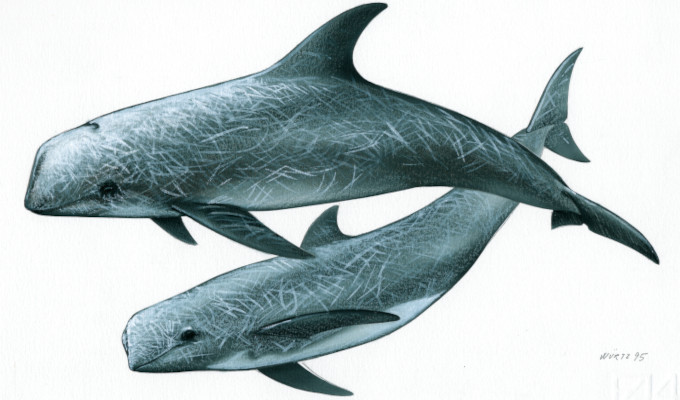Risso's dolphin
Kingdom: Animalia
Phylum: Chordata
Class: Mammalia
Order: Cetartiodactyla
Infraorder: Cetacea
Parvorder: Odontoceti
Family: Delphinidae
Genus: Grampus
Species: Grampus griseus (Cuvier, 1812)

Description
Adults of both sexes reach about 4 meters in length and weigh about 500 kg. The body is well-proportioned, the rostrum absent, and the forehead convex but not globular as in pilot whales. Throughout life, the livery discolors, and in the elderly, the head may turn completely white. Adults have visible light scratches on the skin, especially on the front part of the body, which contribute to their white coloration. Newborns are dark, blackish-brown in coloration.

The Risso's dolphins form small groups of 7-15 individuals that often thin out while searching for food. They feed mainly on cephalopods but also occasionally on small fish. From their stomach contents, it has been observed that they feed on neritic species belonging to the Teuthidae family.
Risso's dolphins are cetaceans abundant in tropical and temperate waters of the world's oceans and generally live on the continental shelf escarpment. In the Mediterranean, the species is described as predominantly pelagic, living between 500 and 2000 meters, with a preference for the upper part of the continental slope between 500 and 1000 meters.
Mediterranean Conservation Status
In 2021, the Mediterranean subpopulation of Risso's dolphins moved from the Data Deficient category to Endangered on the IUCN Red List due to an assumed reduction of more than 50 percent in the number of individuals, calculated over a 10-year period.

The most significant threat in the Mediterranean Sea is bycatch; in Spain and Italy, the fishing gears involved are longline systems and gill nets. Other potential problems include disturbance by boats and ingestion of plastic. Although there is no evidence of Risso's dolphin strandings directly linked to noise pollution in the Mediterranean, the species, being a pelagic deep-diver, is considered at risk. Like other odontocetes in the Mediterranean, Riss's dolphins are also impacted by chemical pollution.
Listed in
CMS App. II (North Sea, Baltic Sea, and Mediterranean populations)
CITES App. II
Bern Convention App. II
Barcelona Convention, SPA/BD Protocol, Annex II
EU Habitats Directive, Annex IV
Global status
Least Concern
The local population
The Risso's dolphin is a rare species in the study area and is not present (or not sighted) every year. However, over time it has been possible, thanks to photo identification, to catalog a total of 45 individuals.

Some animals show strong site fidelity; ten individuals, in particular, have been frequenting the study area for 16 years. Photo-identification analyses on scars and scratches also verified the stability of these marks over time, which are therefore valid for long-term photo-identification.
In the waters of Ischia, grampus have been the subject of a severe episode of anthropogenic disturbance, due to interactions with the numerous recreational boats. The boats unintentionally "pushed" the animals toward land, bottling them up and putting them at risk of stranding.

Risso's dolphins frequent both the slope environment, more offshore with depths of 500/600m, and the coastal environment of the island of Ischia.
Acoustics
The acoustic repertoire of the grampus is still poorly studied. The species, like other delphinids, emits both clicks, whistles, and pulsed sounds.
Whistles are rarer and emitted at frequencies between 5 and 20 kHz; the species also emits low-frequency vocalizations with a powerful harmonic component.

Our study seeks to characterize the acoustic behavior of grampuses in the study area to define a vocal catalog of the repertoire of this population. The objectives of the study include: describing combinations of whistles and pulse sounds, determining whether acoustic behavior is characteristic of various behavioral states, and defining how group size and composition affect vocalization rate.

